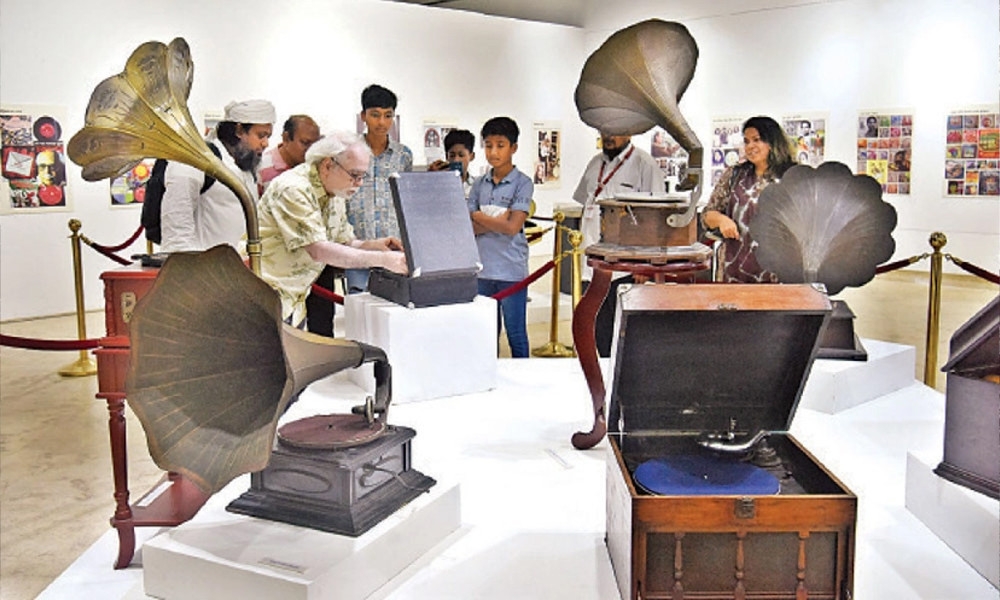

Bangabandhu Sheikh Mujibur Rahman gave his historic speech at Race Course Maidan on March 7, 1971. His birthday is on March 17 after a few days. M Abul Khair, a partner of Dhaka Records, handed over a gramophone record of the speech to Bangabandhu, who became the undisputed leader of Bengali on that day. Bangabandhu’s March 7 speech was not telecast due to restrictions imposed by the Pakistani dictator.

null
Published: May 01, 2024 08:50
exhibition
In the lost time of the call song
Saleh Fuad

nullShamim Aminur Rahman’s special exhibition ‘Song of Call: Sekal-Ekal’ jointly organized by National Museum and Ministry of Culture. Yesterday at Nalinikant Bhattsali Gallery. Photo: Lutfar Rahman
https://cea2b0933188a0e6b07ddc57009b6930.safeframe.googlesyndication.com/safeframe/1-0-40/html/container.htmlBut Pakistan International Film Corporation Chairman AHM Salahuddin and Managing Director M Abul Khair recorded the audio and video of the speech. Bangabandhu was so touched to receive a record of the speech as a gift on his birthday.
A special exhibition of records used in the gramophone, a music listening device of the time , found reference to the historic event on Tuesday. The gramophone instrument was known in Bengali society at that time as the ‘call song’.
https://cea2b0933188a0e6b07ddc57009b6930.safeframe.googlesyndication.com/safeframe/1-0-40/html/container.htmlThis exhibition titled ‘Song of the Call: Sekal-Ekal’ has started at the National Museum with various artifacts of about one and a half hundred years. This exhibition is mainly about the records of different songs from the country and abroad. Apart from this, two Bengali dramas, Palagans, Yatra records have also got a place in it. Along with the world famous artists, there are various types of music from the folk life of the people of Bengal.There are many materials of history.
The exhibition started on Saturday evening at the National Museum’s Nalinikant Bhattasali Gallery . It houses the unique personal collection of architect, writer and museum board member Shamim Aminur Rahman. The exhibition is jointly organized by the National Museum Authority and the Collector .
The exhibit includes examples of the evolution of musical instruments from the early gramophone .A diverse collection of radio and television will also dazzle especially the younger generation. All samples of the exhibition are active. These arranged specimens and various posters pasted on the walls give young people the opportunity to travel through history and make memories for the elderly.
Syed Anwar Hamid, a retired teacher who came to enjoy the exhibition yesterday afternoon , said, ‘Rabindranath’s song spread due to the song of this call. The songs of Kazi Nazrul and Abbasuddin drew the Bengali Muslim community to music through the song of Kaal. A variety of influences were created.’
In 1877, American scientist Thomas Alva Edison invented the first sound recording device ‘phonograph’. A decade later, the German scientist Emil Berliner in 1887 improved the device and named it Gramophone. Edison’s phonograph recorded sound on a metal drum. And the gramophone recorded the sound on a very thin disc. The artist’s vocal music spread through gramophone records to the general public across the country. For a long time, however, this instrument was found in well-to-do and musically cultured families.
Shamim Aminur Rahman’s collection also includes gramophone records recorded at the very beginning of the last century. He told Kal Kantha that in the exhibition , he mainly wanted to show Bengali songs and gramophones from time immemorial. For this, the creation of two Bengals has got more space. He said, ‘I want to show that we also have a tradition and creation to be proud of.’
Shamim Aminur Rahman expressed his gratitude to AHM Salahuddin of Dhaka Record. The first song was recorded on a gramophone in Calcutta in 1902. The artist was Gauhar Jan. AHM Salahuddin came later and started recording in Dhaka. Shamim Aminur Rahman said, ‘People of this country play Hindi songs in wedding ceremonies, but they cannot find Bengali songs. But Salahuddin Sahib of Dhaka Records brought rural artistes from remote areas to record the priceless wealth of Bengali folk songs. The appeal of these songs is still there. Re-recording the songs using modern instruments would be outstanding.’
‘Caller Gan : Sekal Ekal’ exhibition will continue till May 12. Open to all from Saturday to Wednesday from 10:30am to 5:00pm and Friday from 3:30pm to 7:00pm. Will be closed on Thursday.